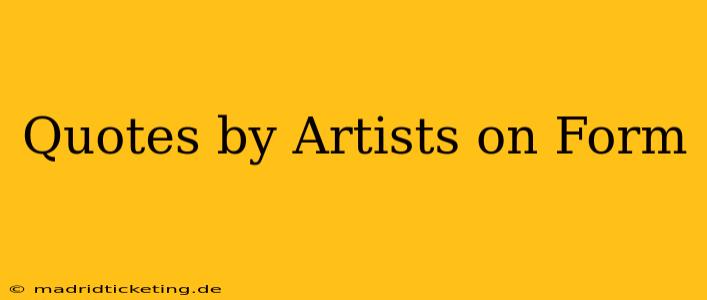Form. A word that evokes images of sculpted marble, the graceful curve of a violin, the vibrant interplay of colors on a canvas. But for artists, form transcends mere physical shape; it's the very essence of their creative expression, a powerful tool used to convey emotion, meaning, and vision. This exploration delves into insightful quotes from artists across various disciplines, revealing their perspectives on the crucial role of form in their work. We'll examine how form interacts with content, technique, and the artist's overall intention.
What is Form in Art?
Before diving into the quotes, it's crucial to define "form" in the context of art. Form encompasses not only the visible shape and structure of an artwork but also its underlying organization, the relationships between its elements, and the overall aesthetic impact it creates. It's the interplay of line, color, texture, space, and composition that contributes to the artwork's unique character and communicative power.
Artist Quotes on the Power of Form
Here are some thought-provoking quotes from artists who illuminate the significance of form in their creative process:
"The artist must create his own form...He must not copy existing forms." – Wassily Kandinsky
Kandinsky, a pioneer of abstract art, emphasizes the importance of originality and innovation. For him, form is not about imitation but about the unique expression of the artist's inner vision. He believed that form could be a powerful vehicle for conveying spiritual and emotional experiences.
"Content dictates form." – Unknown (This is a common artistic principle, often attributed to various artists)
This statement highlights the fundamental relationship between content and form. While form is the visible structure, content is the meaning or idea being conveyed. The artist carefully shapes the form to best communicate the intended content. A powerful message requires a form that adequately supports and enhances it.
"I believe in the power of form. I believe that form can affect human perception and emotion." – Anish Kapoor
Renowned sculptor Anish Kapoor underscores the profound influence form exerts on viewers. His large-scale sculptures often explore the interaction between form and space, challenging perceptions of scale and evoking powerful emotional responses.
"The form is what matters. The concept is secondary." – Constantin Brancusi
Minimalist sculptor Constantin Brancusi prioritizes the visual impact and inherent qualities of form. He believed in stripping away unnecessary elements to reveal the essence of form's expressive power.
What are the different types of forms in art?
This question touches on the various elements that contribute to artistic form. In visual arts, we have organic forms (mimicking natural shapes), geometric forms (precise and mathematical), and abstract forms (non-representational). In music, form involves structures like sonata form, rondo form, and variations. In literature, it's the narrative structure, the arrangement of plot elements, and the overall style. Each art form has its unique vocabulary of form.
How does form relate to function in art?
The relationship between form and function varies across art disciplines. In functional art, like pottery or furniture, form and function are intrinsically linked. The object's form must serve its intended purpose. However, in non-functional art, the function is primarily aesthetic—to provoke emotion, stimulate thought, or create a beautiful experience. The form's effectiveness is judged by its ability to achieve this aesthetic purpose.
How do artists use form to create meaning?
Artists utilize form to create meaning in countless ways. Shape, scale, proportion, and composition all contribute to the overall narrative and the emotional resonance of the artwork. For example, a sharp, angular form might suggest tension or aggression, while a smooth, curved form might suggest serenity or grace. The arrangement of forms within a composition can also communicate relationships, create balance, or generate dynamic tension.
What is the difference between form and style?
Form relates to the structural elements of the artwork, while style encompasses the artist's unique approach to creating those elements. Two artists might use similar forms (e.g., cubist shapes) but display drastically different styles based on their individual techniques, choices of materials, and overall aesthetic preferences.
Conclusion: The Enduring Power of Form
The quotes and discussions above illustrate the central importance of form in artistic creation. It's not a mere shell or container but a vital element that shapes the artwork's expressive potential. Through the skillful manipulation of form, artists can communicate a vast array of emotions, ideas, and experiences, leaving a lasting impact on their audience. The exploration of form is an ongoing journey, constantly evolving and pushing the boundaries of artistic expression.

